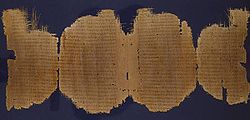Feb
6
Doubting the Gospel of Thomas (Part 1 of 3)
Some time ago, I had an interesting discussion with a guy on a (marketing) forum about various aspects of Biblical reliability & canonicity, testing historical manuscripts, corruption in “The Church”, differences between major Christian branches, etc. It ran quite the gamut, with several threads going at once. At some point, I decided to start copying the exchange into simple text files for posterity… or, rather, to review later and see where I could’ve explained myself better. I think there was some pretty good stuff in there, so I’ve decided to piece together some back-n-forth comments to post here on a few subjects. (In fact, I already did one such post this past Christmas: Are the Gospel Nativity Accounts Contradictory?.)
 A couple other people chimed in occasionally, but my main “opponent”/challenger’s name was Michael, though during these discussions I think he went by the handle “Heathen Gnostic”. If I remember right, I eventually determined he was a lapsed Catholic-turned-agnostic, perhaps somewhat partial to a generic paganism, and definitely enamored with what he thought gnosticism was all about (i.e., always seeking knowledge). He was quite knowledgeable about marketing (and other things), and I learned a lot from him. But, he could be rather blunt and in-your-face with his challenges or accusations, and he usually didn’t recognize when he was guilty of biased and/or unclear thinking himself, which is what he accused Christians and other religious people of doing.
A couple other people chimed in occasionally, but my main “opponent”/challenger’s name was Michael, though during these discussions I think he went by the handle “Heathen Gnostic”. If I remember right, I eventually determined he was a lapsed Catholic-turned-agnostic, perhaps somewhat partial to a generic paganism, and definitely enamored with what he thought gnosticism was all about (i.e., always seeking knowledge). He was quite knowledgeable about marketing (and other things), and I learned a lot from him. But, he could be rather blunt and in-your-face with his challenges or accusations, and he usually didn’t recognize when he was guilty of biased and/or unclear thinking himself, which is what he accused Christians and other religious people of doing.
In this particular thread, I didn’t record his original statement about the so-called Gospel of Thomas (GTh) — which was in the news, at the time –, but he essentially claimed that it was one of several, equally legitimate “Christian” documents that some early Christian leaders had removed from the official Bible, because it contained stuff they didn’t like in it.
My initial response was:
“How could the Church have removed it… if it was never part of the Bible in the first place?
The ‘Gospel of Thomas’ was a Gnostic text discovered with the rest of the Nag Hammadi ‘library’ in Egypt in 1945. Generally dated about AD 140-170, this particular text purports to record 114 ‘secret sayings’ of Jesus. As the scholar Raymond E. Brown said, ‘[W]e learn not a single verifiable new fact about Jesus’ ministry and only a few new sayings that might plausibly have been His.’
Like much of the Gnostic Gospels, the Gospel of Thomas often cites or borrows from the canonical New Testament books. However, and more importantly, Gnosticism in general teaches much that is inconsistent with that believed and taught by the early Christians. The early Church fathers condemned it as heretical.
So,… the Gospel of Thomas was at best practically useless and at worst heresy. And it was *never* part of the Biblical canon.”
In his response to this and a few other statements, Michael replied:
> I also find it interesting about the claim
> Thomas’ work borrowed from other works which
> did end up being compiled into the Bible.> WHO is to say that those other works did not
> borrow from Thomas?
[Note: I will continue to reproduce Michael’s responses verbatim and with the “>” line-headers.]
I felt that I needed to preface any further statements by clarifying what those that study these things professionally say about the dating and authoritativeness of certain manuscripts:
“Just to state for the record, when we talk of certain manuscripts being ‘authoritative’, this is in regards to the historicity of Jesus of Nazareth, both in the events of His life/death/resurrection and what He (and later His apostles) actually taught.
As you stated in your response to Phil, the dating of a manuscript can indeed have strong bearing on its authoritativeness. In this particular case, where two manuscripts have some material in common, the one dated earlier could very well be the ‘original’. Or, there may have been one or more other source(s) (written or oral) that the other two got the material from.
As it is, the canonical Gospels are conservatively dated from AD 65-100, which is at least a preliminary indication that they could be more authoritative than the Gnostic texts. While the manuscripts of both ‘camps’ include doctrines/traditions that were around earlier, it is my understanding that the historical evidence points to that seen in the canonical Gospels appearing decades earlier than Gnostic teachings.
In addition, the canonical Gospels are both historically reliable and simply much closer to the authority of Jesus himself. Even world-class (and non-Christian) historians like Michael Grant and A.N. Sherwin-White agree that, when judged according to standards of ancient historiography in terms of date & reliability on issues that can be compared to other known data, the canonical Gospels measure well and ought to be accepted as good sources for historical information about Jesus.
N.T. critical scholar A.M. Hunter pointed out several reasons why the Gospels are trustworthy sources, which may be summarized as follows:
1) The earliest Christians were meticulous in preserving the tradition of Jesus’ words and life.
2) The Gospel writers were close to the eyewitnesses and pursued the facts about Jesus.
3) There are indications that these authors were honest reporters.
4) The overall composite of Jesus as presented in the four Gospels is essentially the same.Of course, there are other considerations for determining authoritativeness, but I’ll stop there.”
Regarding dating of the Gospels, Michael came back with:
> This is an interesting point because
> according to the gnostic library website,
> Thomas’ Gospel is considered the older.> Which adds another element to it. Instead of
> disagreement about content. There is
> disagreement about age.
Not surprisingly, Michael’s research on dating of manuscripts was somewhat cursory and one-sided. Fortunately, I had done a bit more reading on the topic and went back to review my sources. I responded:
“Yes, conservative theologians generally date the Synoptic Gospels to the AD 60s thru about AD 70. I understand that liberal theologians (e.g., H. Koester, J. Robinson, the Fellows of the Jesus Seminar) typically date the Synoptics at AD late-60s to late-90s, whereas they put GTh & some other Gnostic texts at AD 30-60. (I think most liberals & conservatives agree that the Gospel of John was written in the 90s.) To use your own words, ‘according to the opinions of those who have a vested interest.’ It works both ways.
Btw, I came across more info on the relative dating of GTh, which I may post on later.”
I hope this has been of interest to some of you. I’ll be posting a Part 2 soon, which gets a little more confrontational but also clarifies what gnosticism is all about and includes some specific examples of sayings from the Gospel of Thomas in my follow-up to the manuscript-dating issue. Stay tuned….
















